
Thomas Webb & Sons 'Ivory' Cameo Glass Vase, 1880s, 20cm High
A Thomas Webb & Sons 'Ivory' cameo glass vase, 1880s, of bulbous form with a slender neck and a scalloped rim, decorated with flowers, foliage and a butterfly, the cameo work stained in brown enamel, acid etched arched mark, Thos Webb & Sons underside, 20…

Webb & Sons Three-Color Cameo Glass Vase, Late 19th Century
A Thomas Webb & Sons three-colour cameo glass vase, late 19th century, circa 1890, ovoid bottle shape, carved and overlaid in translucent red and opaque white on a yellow glass ground, decorated with flowers and foliage, acid etched circular mark, Thos…

Antique English Three-Coloured Cameo Glass Vase with Peony Decoration
Thomas Webb stunning antique English three coloured cameo glass vase with trailing peony decoration, 19th century, 10 cm high, 12 cm wide

Webb Antique English Cameo Glass Vase by Lionel Pearce
Webb antique English cameo glass vase by Lionel Pearce, signed 'Lionel Pearce', stamped 'Webb' on the base, 22.5 cm high

Rare Webb & Sons Signed Cameo Glass Vase, 10.8cm Height
Signed Thomas Webb & Sons cameo glass vase, height 10.8 cm

Webb Cameo Glass Vase: Enamel Foliate Motifs & Insects
Webb cameo glass vase, of squat baluster form with an elongated neck, decorated in white enamels with foliate motifs and insects, double ring borders to foot and rim, height 32 cm

Italian Ruby Glass Cameo Stem Beaker - Vintage
A vintage Italian ruby glass beaker with opaque cameo stem, 39.5 cm high

Cameo Glass Vase with Butterfly and Flowers
An overlaid cameo glass vase, attributed to Thomas Webb, circa 1890, carved with a trailing flower stem and a butterfly to the reverse on a bright yellow ground, 10.5 cm high
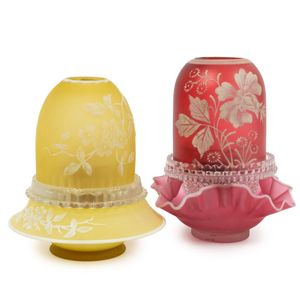
Webb Citron & Red Cameo Glass Fairy Lamps
A Thomas Webb citron cameo glass fairy lamp together with a red cameo glass lamp, late 19th century, the lemon shade featuring a delicately carved flowering stem issuing from the rim and raised on a concave footed base, and a red cameo shade on a frilled…

Pink and White Cameo Glass Bowl with Butterfly and Vines
Thomas Webb cameo glass bowl, of squat form with a pinched rim, decorated with trailing vines and butterfly, in tones of pink and white, incised marks to base, height 7.5 cm and diameter 15 cm
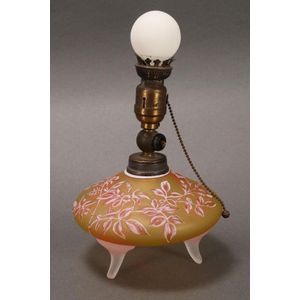
Webb cameo glass lamp with floral decoration
Thomas Webb cameo glass lamp, of petit form, decorated with flowers and foliage, in tones of yellow, orange and white, raised on three frosted glass feet, height 21 cm

Ruby Morning Glory Cameo Glass Bowl
Thomas Webb cameo glass bowl, with a frilled lip, in ruby glass, decorated with overlay morning glory flowers, height 12 cm and diameter 26 cm
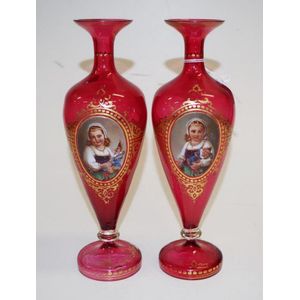
Cameo Ruby Glass Portrait Vases with Gilt Decoration
Pair cameo ruby glass portrait vases gilt decoration to ruby glass footed vases, each with painted portrait in cartouche, height 27 cm each.

Webb Amber and White Cameo Glass Vase
A Thomas Webb cameo glass vase, with an amber glass body overlaid with a white floral design, height 18 cm, diameter 9 cm

Miniature Pink and White Cameo Glass Vase by Thomas Webb
A Thomas Webb miniature cameo glass vase, with a globular form, delicately carved in pink and white, height 3.5 cm, diameter 4 cm

Victorian Cranberry Glass Floral Cameo Vases, 30.5 cm Height
A pair of Victorian cranberry glass & gilt vases with floral cameo, height 30.5 cm

Gilded Webb Cameo Glass Dessert Set
A gilded cameo glass dessert service by Webb, 19th century, comprising two comports and eight plates each with an opaque ivory ground ornately etched and gilded with scrolling floriate and foliate decoration, stamped 'Webb' to the base, the plates 24 cm…

Webb cameo glass vase: Frosted amber with white overlay
A Webb cameo glass vase, circa 1890 of squat baluster form the frosted amber glass wall carved and overlaid in opaque white flowers and leafage 8 cm high

Webb cameo glass vases with delicate floral carving
Two Webb cameo miniature glass vases, English, circa 1885 each of globular form delicately carved in pink, white and yellow with leafy blossom and prunus 5.5 cm high

Webb cameo glass vase with white floral overlay
A Webb cameo glass vase, circa 1890 of squat baluster form the frosted blue glass wall carved and overlaid in opaque white flowers and leafage 9.5 cm high

Primrose and Butterfly Cameo Glass Vase
A Thomas Webb & Sons cameo glass vase, circa 1890 - 1900 the translucent bottle form yellow glass body overlaid with opaque white and pink, carved with primroses, leafy stems and butterflies, acid etched circular mark, Thomas Webb & Sons cameo 19 cm high

Webb & Sons Cameo Glass Vase with Spring Flowers
A Thomas Webb & Sons cameo glass vase, circa 1890 - 1900 the translucent ovoid yellow glass body overlaid with opaque white and pink, carved with spring flowers, leafy stems and butterflies, acid etched circular mark, Thomas Webb & Sons cameo 15 cm high

Webb cameo glass vase with spring flowers
A Webb cameo glass vase, circa 1900 the translucent ovoid yellow glass body overlaid with opaque white and pink, carved with spring flowers, leafy stems and berries '??????12.5 cm high
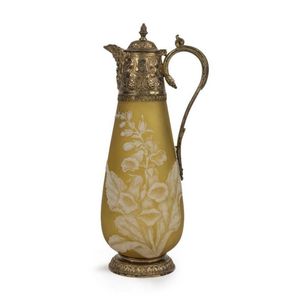
Silver Mounted Cameo Glass Claret Jug with Foxgloves
A rare silver mounted cameo glass claret jug attributed to Thomas Webb & Sons maker's mark Joseph Cook & Son, Birmingham, 1880 the tapering yellow ground body overlaid in opaque white, finely carved with foxgloves and leafage, with a Bacchus mask spout…

Ivory Cameo Glass Vase with Foliate Scroll Work
A Thomas Webb & Sons ivory cameo glass vase, circa 1885 of baluster form with a pale caramel coloured ground, carved in shallow relief with a continuous frieze of foliate scroll work, heightened in brown enamel, impressed mark THOS WEBB & SONS 15.5 cm high
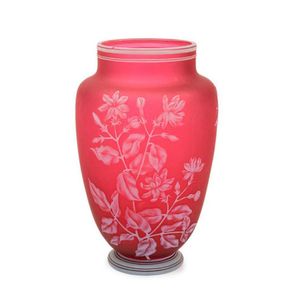
Webb & Sons Cameo Glass Vase with Honeysuckle and Butterflies
A Thomas Webb & Sons cameo glass vase, circa 1890 - 1900 Webb pattern number W1444, marked Gem Cameo of shoulder form in ruby red glass overlaid in opaque white and carved with honeysuckle, leafy stems and butterflies, acid etched circular mark Thomas…

Webb cameo glass vase with white floral overlay
A Webb cameo glass vase, English, circa 1885 finely carved throughout with an overlay of flowers and leafage in white on a ruby red ground 13 cm high

Webb Cameo Glass Vase with White Flowers and Leaves
A Webb cameo glass vase, circa 1890 of squat baluster form the frosted ruby glass wall carved and overlaid in opaque white flowers and leafage 9.5 cm high

Webb Cameo Glass Vase with Spring Flowers
A Webb cameo glass vase, circa 1890 the translucent serpentine form ruby glass body overlaid with opaque white carved with spring flowers, leafy stems and butterflies 34.5 cm high

Rare Thomas Webb & Sons Ivory Cameo Glass Candlesticks
A rare pair of Thomas Webb & Sons ivory cameo glass candlesticks, circa 1885 designed by George Woodall and painted by Jules Barbe, pattern I 499 each finely decorated throughout with classical foliate and floriate motifs, the cameo work heightened in…

Webb & Sons Ivory Cameo Glass Biscuit Barrel
Thomas Webb & Sons cameo type glass biscuit barrel, the spherical body of single ivory tone, cut in relief with an encircling flowering vine, silver plate lid and swing handle, engraved maker's marks to the base, diameter 15 cm.

Yellow Flower Cameo Glass Vase, Late 19th Century
A Thomas Webb & Son style cameo glass vase late 19th century depicting flowers on a yellow ground. Height: 23.5 cm

Blue Butterfly Cameo Glass Vase
A Thomas Webb & Son style cameo glass vase late 19th century depicting white flowers & butterflies on a blue ground height 22.5 cm

19th Century Cameo Glass Vase with White Flowers
A Thomas Webb & Son style cameo glass vase late 19th century, depicting white flowers on a yellow ground,in 3 colours height 25 cm

Webb & Co. Cameo Vase with Bramble Fruits and Butterfly
A Thomas Webb & Co. cameo vase, late 19th century, the waisted baluster vase finely decorated with a stem of bramble fruits with, flowers in white upon a rich aqua blue ground, with butterfly to the reverse, unmarked, height 15 cm

Webb & Co. Cameo Vase, Late 19th Century
A Thomas Webb & Co. cameo vase, late 19th century, the ovoid vase with a waisted neck and foot, decorated with a floral stem in white upon a lemon ground, maker's mark in low relief to crescent banner, underside, height 13 cm

Webb & Co. Two-Color Cameo Vase, Late 19th Century
A Thomas Webb & Co. two colour cameo vase, late 19th century, the elegant vase of compressed form with a waisted stem, decorated with a leafy branch and flower buds in white and copper red colours upon a matte, golden amber ground, maker's mark in low…

Victorian Cranberry Cameo Glass Vase with Wildflowers
A Victorian Thomas Webb cameo glass vase, wild flowers in white on a cranberry ground with white embellishments to base and top. 10 x 15.5 cm.

Victorian Nasturtium Milk Glass Vase
A Victorian Thomas Webb & Sons milk glass cameo bottle vase, decorated in relief with nasturtium flowers and vines, impressed mark to base. height 22 cm.

Victorian Webb Olive Green Cameo Glass Vase with Wildflowers
A Victorian Thomas Webb cameo glass vase, wildflowers in white on an olive green ground, white band to the rim and base, width 12 cm, height 18 cm.

War and Peace Pate Sur Pate Glass Vases
Pair Victorian pate sur pate glass vases flattened cylindrical bodies with cameo panels of war and Peace (one a/f)

Victorian Uranium Cameo Glass Vase with Enamel & Gilt Decoration
Victorian Uranium cameo glass vase with hand applied enamelled and gilt decoration c.1890's

Antique Cut Cameo Glass Covered Urn by Thomas Webb & Sons
A small Thomas Webb & Sons cut cameo glass covered urn, circa 1890, 7.5 cm high

Webb & Sons Cut Cameo Glass Jar with Silver Cover
A Thomas Webb & Sons cut cameo glass jar, circa 1890, with a later silver plate collar and cover, 14 cm high

Cameo Glass Wine Jug with Silver Plate Mount
A Thomas Webb & Sons style cameo glass silver plate mounted wine jug, circa 1890, the ovoid pink glass body cameo cut and etched in opaque white glass of apple blossoms and leaves, with a silver plated mounted collar, lip, hinged cover with a beaded urn…

English Richardson & Sons Tall Spill Vases with Cameo Panels
A pair of English Richardson & Sons overlay and cameo panelled tall spill vases having shape top and ornate gilding, 34 cm high

Webb Cameo Glass Vase with Floral and Butterfly Design
A Thomas Webb floral and butterfly decorated cameo glass vase, impressed mark to base, 25.5 cm high

Yellow Cameo Glass Flower Vase by Thomas Webb
Thomas Webb yellow cameo glass flower vase having frosted & clear glass detail, with a raised coloured stamp to the body & an acid stamp to the base. Height 22.5 cm

Stourbridge Cameo Glass Perfume Bottle, circa 1880
A Stourbridge cameo glass perfume bottle, in the manner of Thomas Webb, circa 1880, the Siros Collection, South Australia, the tapering ruby body overlaid in white, carved with palm leaves and a butterfly beneath one shoulder, rising to a silver plate…

Victorian Enamelled Glass Vase with Thistle and Wheat Cameo
A Victorian egg shell Bristol glass vase, with enamelled thistle flower and wheat cameo, gilt trim, circa 1880. Height 28.5 cm.

19th Century Floral Cameo Glass Bottle Vase
A 19th century cameo glass bottle vase, possibly Webb, Compressed in form, carved with a traditional floral motif, 12 cm high

Webb cameo glass vase with floral and insect relief decoration
A good Thomas Webb cameo glass vase, the squat ovoid body with encircling band of traditional cut, floral vine decoration, the tall baluster neck with single leaf spray and insect in relief, linial encircling bands to the foot and top rim, double overlay,…

Richardson & Co. Cameo Glass Urns with Overlays
A pair of Richardson & Co. cameo and overlaid glass urns and covers. 23 cm high.

Victorian Cut Back Cameo Glass Biscuit Barrel
A late Victorian cut back cameo glass biscuit barrel, later 19th century, the tapering ovoid barrel decorated with acid green diamond cuts and oakleaf and acorn designs in alternating vertical panels, surmounted by a plated mount with a swing handle and a…

Webb cameo glass vase with wild roses
A fine cameo glass vase by Webb, late 19th century, of bottle vase form in frosted lemon satin glass, delicately and naturalistically overlaid with trailing white wild roses throughout, a white border to the rim. Height 22.5 cm

Victorian Ruby Glass Trumpet Vase with Cameo and Gilt
A Victorian ruby glass vase, trumpet shape, with a painted cameo and gilt decoration. 32 cm high

Victorian Triple Layer Cameo Vase
A late Victorian triple Layer cameo vase in the manner of Thomas Webb, circa 1890s, the globular vase with a straight neck, in a subtle satin chartreuse hue overlaid with orange and white, depicting delicately trailing clematis blooms to the body and neck…

Victorian Cameo Glass Vase with Wild Rose Design
A late Victorian cameo glass vase in the manner of Thomas Webb, circa 1890s, the fine 'Rose du Barry' satin bottle vase overlaid with a delicate trailing wild rose design in white to the body and neck; unmarked but bearing a Webb style 'Butterfly' motif…

Webb Cameo Glass & Silver Seal by Gorham
A Thomas Webb cameo glass and sterling silver seal, later 19th century, with silver maker's marks for Gorham, the seal of typical elongated baton form in semi opaque chartreuse glass overlaid with white carved lilies, the silver collar with simple beaded…

Amber Art Deco Cameo Glass Vase
An Art Deco Thomas Webb cameo glass vase, circa 1930s, the striking vase of exaggerated trumpet form with random slice and lens cut motifs throughout in amber amidst a semi opaque clear textured ground, with a fire polished rim and polished pontil. Height…

Webb & Sons Cameo Glass Vase with Floral Decoration
Thomas Webb & Sons cameo glass vase c.1890, decorated with leaves and flowers. Note: AF-reduced rim, signed impressed mark 'Webb'. Height 12.8 cm

Ivory Cameo Glass Vases with Lilies and Butterfly
Pair of Thomas Webb & Sons ivory cameo glass, vases c.1890, decorated with lilies and a butterfly, the surface of the glass is cameo cut with brown, patination simulating ivory, signed impressed marks 'Thos. Webb & Sons' with 'Butterfly' trade mark in…

Dragonfly Foliage Cameo Glass Vase by Thomas Webb & Sons
Thomas Webb & Sons cameo glass vase c.1900, two colour cameo decorated with white foliage and dragonfly verso, signed impressed mark 'Tho. Webb & Sons'. Height 12 cm

Cameo Glass Vase by Thomas Webb & Sons, 1890
A Thomas Webb & Sons cameo glass vase, c.1890, Stourbridge England. The vase is decorated with two colour wheel cut, cameo glass with white foliage decoration and 'Butterfly' mark verso Impress, semi circular mark, to base 'Thomas Webb & Sons'. Height 10…

Thomas Webb Cameo Glass Vase
A rare cameo glass vase by Thomas Webb, circa 1900, globular, cut with bell shaped flowers in white on a ruby red ground, impressed factory stamp to base. 28 cm high

Webb Frosted Ruby Claret Jug with Embossed Design
Superb Webb cameo frosted ruby claret jug, of subtle tapered proportion, the body decorated with entwined flowers and vine, the plated mount having embossed decoration echoing the design on the body of the jug. Height 30 cm

 Loading more...
Loading more...